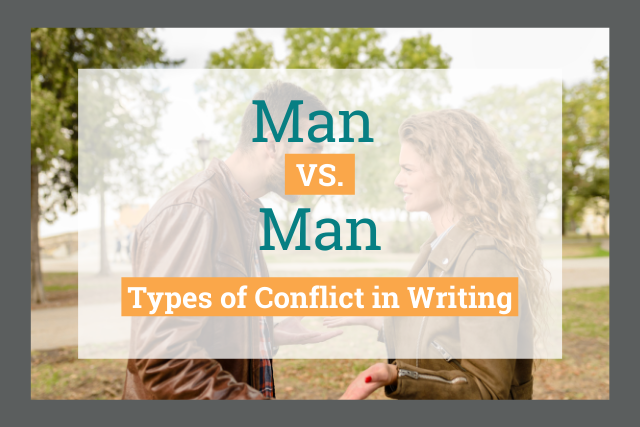
Good guy vs. bad guy. Protagonist vs. antagonist. Hero vs. villain.
All of these terms mean the same thing: man vs. man conflict. This conflict type (which pits two characters in direct opposition to each other) is one of the most common in literature because the vast majority of stories have a protagonist and an antagonist.
In fact, you can probably think of many bestsellers and blockbuster hits with man vs. man conflicts! Today, we’re going to learn what this type of conflict is and what makes it so popular.
What Does Man vs. Man Conflict Mean?
Man vs. man is a type of conflict where two characters are in direct opposition to each other. The driving force of the conflict is how these two interact, and how the antagonist keeps the main character from achieving their goals.

Man vs. man is a misleading name. The conflict can involve any two characters.
Of course, this could mean other genders are in conflict, but it can also involve non-human characters. The Lion King features two lions, Simba and Scar, as the protagonist and antagonist. This story still counts as man vs. man conflict.

Many readers, scholars, and writers prefer to use other terms for this type of conflict. You might see it written as person vs. person, character vs. character, or individual vs. individual. We’ll use these terms interchangeably in this article.
Is Man vs. Man an Internal Conflict or an External Conflict?
There are seven types of conflict that can be lumped into two categories. Internal conflicts happen within the character. The source of the conflict is unseen to the outside world. External conflicts happen between the character and an outside or external force.
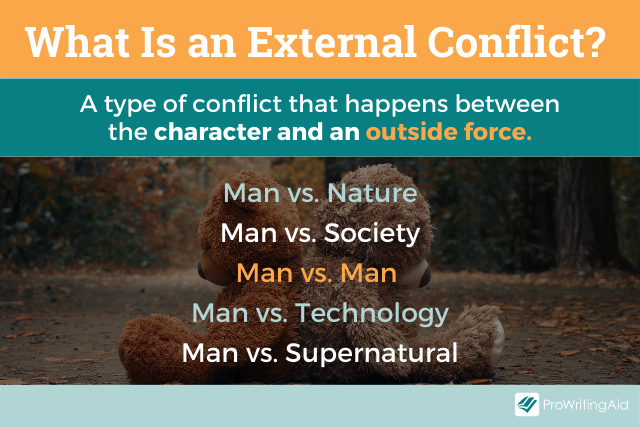
Character vs. character is a type of external conflict. The other external conflicts are man vs. society, man vs. nature, man vs. technology, and man vs. supernatural. Man vs. self conflict and man vs. fate conflict are both internal.
A story can have multiple conflicts, and character vs. character stories usually feature at least one other type of conflict. Returning to our example of The Lion King, this classic family film is also an example of man vs. nature conflict because a drought and famine decimate the land the lions live on. It’s also a man vs. fate conflict because Simba must accept his destiny as the king.
Another great example of a man vs. man story that has other conflicts is The Strange Case of Dr. Jekyll and Mr. Hyde by Robert Louis Stevenson. The plot involves Gabriel Utterson trying to discover who the devious Mr. Hyde is and how he’s involved with Utterson’s friend, Dr. Jekyll. This external conflict drives the events of the story.
However, the true themes of the story can be found in the man vs. self conflict. Mr. Hyde is the monstrous, hedonistic side of Dr. Jekyll. The man is quite literally at war with himself. It takes the man vs. self conflict to a very literal level, while still remaining a character vs. character story.
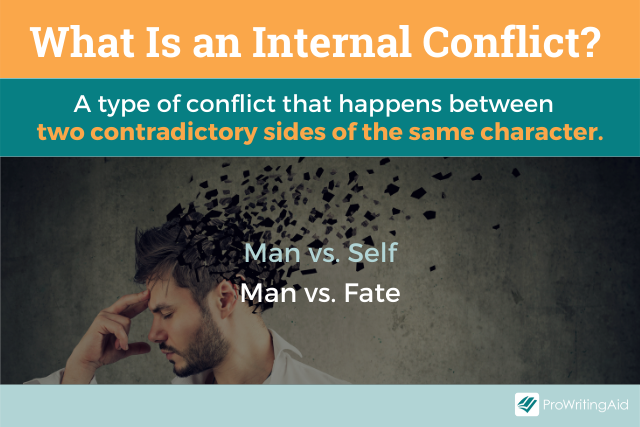
Writers create conflict in multiple layers. Stories often feature an external conflict and an internal conflict. They can also feature multiple types of each conflict. We’ll look at some other examples later.
What Genres Use Man vs. Man Conflict?
Because it’s such a versatile and open-ended external conflict, character vs. character can be used in any genre. There is usually at least one character in opposition to the protagonist in most stories.
In literary stories, the two conflicting characters often represent different themes. The person vs. person conflict is used to illustrate a deeper meaning. In Dr. Jekyll and Mr. Hyde, Jekyll represents good and Hyde represents evil. Together, their conflict represents the good and evil within each person and the dangers of letting our internal evil win.
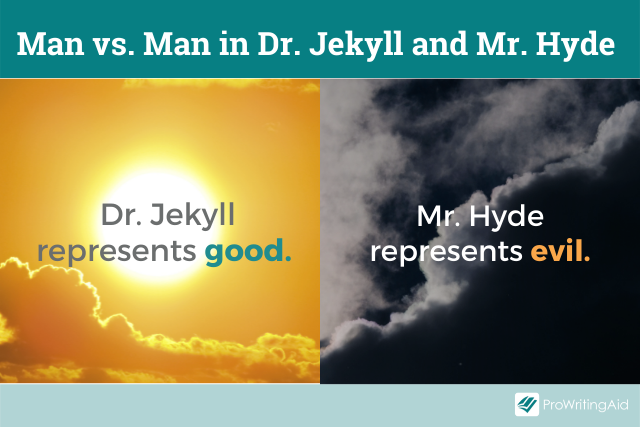
In genre fiction, the person vs. person conflict might be more literal, but it is used as a tool to create the overall theme and message of the story. For example, in the original Star Wars, the main external conflict is between Luke Skywalker and Darth Vader. But their conflict illustrates not just good vs. evil but also problems with imperialism and totalitarian rule.
Character vs. character conflict is popular in children’s fiction because it’s a simple concept to understand. It’s also the main conflict in most crime novels, mysteries, and thrillers.
It’s often used as one type of external conflict in genres like fantasy and science fiction, along with larger ones like the man vs. society or man vs. nature conflict, or an internal conflict like character vs. self. We bet you can open just about any book and find at least one plot line that is a character vs. character conflict!
Does Man vs. Man Always Mean a Good Guy and a Bad Guy?
Character vs. character conflict is also commonly used in romance—but there’s not usually a good guy and a bad guy in love stories, right?
The man vs. man conflict does not have to mean a hero and a villain or the classic good guy/bad guy trope. It is the conflict between the protagonist and antagonist.
What’s the difference? Well, the protagonist is the main character of the story. The antagonist is the character standing in their way. They are causing some sort of conflict that is keeping the main character from reaching their goals. There can be primary, secondary, and even tertiary antagonists!
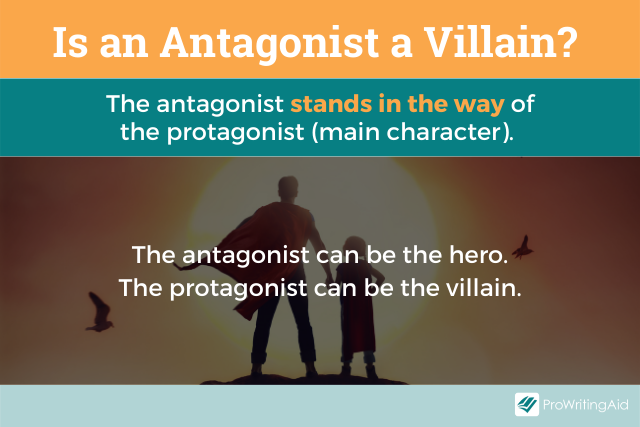
This means that while villains are antagonists, not all antagonists are villains. The romance genre is a great example of when person vs. person does not involve a bad guy.
Pride and Prejudice by Jane Austen is one of the most popular love stories of all time. The protagonist is Elizabeth Bennet. She is smart, witty, and very proud, and she has no great desire to get married despite what her family expects. The antagonist is Mr. Darcy. He is proud, arrogant, and very prejudiced against lower-class families like the Bennets.
Mr. Darcy insults Elizabeth on multiple occasions. He foils her sister’s chance at happiness by convincing his friend Bingley not to marry Jane Bennet. Elizabeth wants nothing more to do with him, and yet he keeps showing up. He even helps her family avoid scandal.
He’s not a bad guy, and Elizabeth doesn’t need to defeat him. She marries him instead. But he’s still the primary antagonist of the story. Through their major conflict with each other, they also deal with their own internal conflict that put them at odds: pride and prejudice.
It’s not just romance where writers use this type of person vs. person conflict. If it’s not clear who the antagonist in a story is, look for who is standing in the way of the main character’s goals.
What Is an Example of Man vs. Man Conflict?
We’ve looked at a few examples of the character vs. character conflict in books and movies. Let’s check out some more.
What Are Some Bestselling Books with Man vs. Man Conflict?
Here are some person vs. person books that have topped bestseller lists.
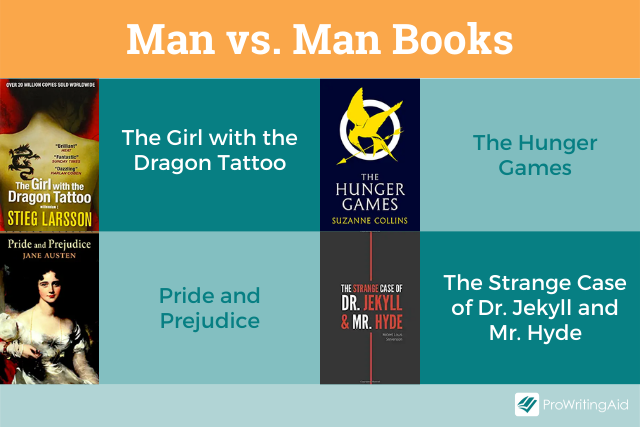
The Harry Potter series by J.K. Rowling follows the main character, Harry, as he fights and seeks to destroy the villain, Voldemort. The character vs. character conflict drives the plot of the story through seven books. It’s not the only character vs. character conflict, either. There are times when Draco Malfoy is in direct conflict with Harry. There are even times that Dumbledore stands in the way of Harry’s goals by not disclosing information. The series also uses the character vs. supernatural and character vs. fate conflicts.
The Girl with the Dragon Tattoo is a Swedish psychological thriller by Stieg Larsson. It became a worldwide bestseller when it was published after the author’s death. This thriller follows disgraced journalist Mikael Blomkvist and hacker Lisbeth Salander as they try to solve a cold case about a millionaire’s niece who vanished decades earlier. There are multiple character vs. character conflicts in the book. There is the conflict between the mysterious serial killer and the main characters. Blomkvist is also in conflict with a corrupt businessman he tried to expose. There is family conflict in the Vanger family. And Lisbeth has a gruesome conflict with her court-appointed guardian.
The young adult dystopian novel Hunger Games, by Suzanne Collins, became a huge hit and launched a popular era of dystopian YA fiction. There are many different conflicts in this book and its sequels. The character vs. character conflicts occur primarily between Katniss and the other contestants as they fight for survival. Katniss is also in conflict with President Snow directly, but she doesn’t know it at first. There are also several other conflicts to portray the wider themes. The Hunger Games contest is a character vs. nature conflict that pits children in hostile environments for survival. As the series progresses, Katniss faces a character vs. self-conflict in choosing to be a figurehead for the rebellion. And like all dystopian fiction, the primary conflict is character vs. society.
Man vs. Man Conflict in Movies
Movies also commonly feature character vs. character conflicts. Here are a few examples.
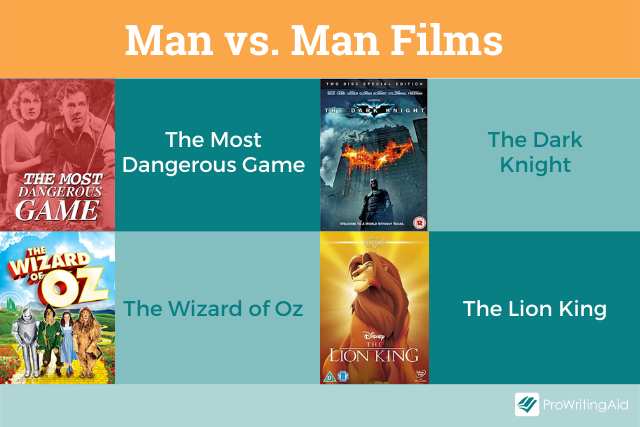
The Most Dangerous Game is a 1932 horror film based on a short story of the same name. In this movie, a big game hunter named Bob Rainsford survives a shipwreck and finds himself on a private island owned by another big game hunter, Zaroff. Zaroff has moved onto more interesting prey. He hunts Bob in a game of cat and mouse on the island. The movie uses the man vs. nature conflict in the island’s environment as a backdrop to the story.
Superhero stories often feature person vs. person conflicts. The Dark Knight pits Batman against the Joker. The Joker wants Batman to reveal his true identity. The insane villain hatches violent, manipulative plots as Batman tries to stop him from murdering more people. A second person vs. person conflict shows up when the Joker recruits Harvey Dent as Two-Face. Two-Face becomes another murderous villain driven by rage at the death of the woman he loved. Batman as Bruce Wayne also faces a character vs. self conflict. This internal conflict deals with the deciding whether to give up his secret identity and crime-fighting persona to save people.
Finally, the classic movie The Wizard of Oz is a fantasy film with a character vs. character conflict. The Wicked Witch of the West holds Dorothy responsible for killing her sister, even though it wasn’t Dorothy’s fault. Dorothy wants nothing more than to get home and goes on a quest to meet the Wizard, but she is hunted by the Wicked Witch the entire way. To be granted the power to return home, the Wizard tasks Dorothy with killing the Wicked Witch. This makes the Wizard the secondary antagonist of the story.
Using Man vs. Man Conflict in Your Writing
It’s hard to find a story that doesn’t have person vs. person conflict—you might even be using it yourself in your own fictional story. This type of conflict may be common, but that doesn't make it any easier to write. Seeing how you stack up against authors who use this dynamic can help.
ProWritingAid’s author comparison feature allows you to select your favorite author and compare your writing to theirs in a number of areas like dialogue tags, emotional tells, sentence structure, and more.
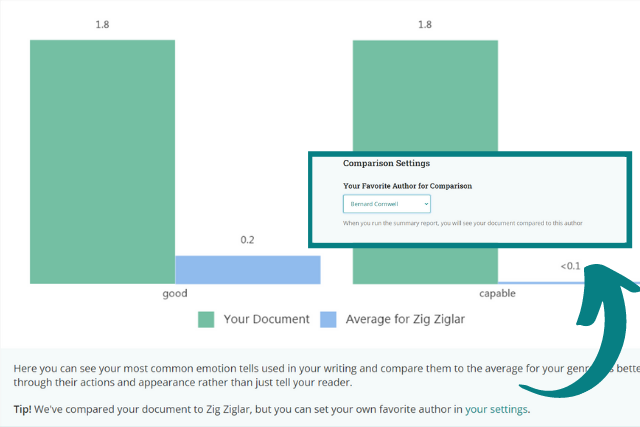
While this won't tell you how to structure your conflict, it'll give you a good idea of the techniques they used to create effective stories.
Try the author comparison feature with a free ProWritingAid account.
What are your favorite man vs. man stories?

